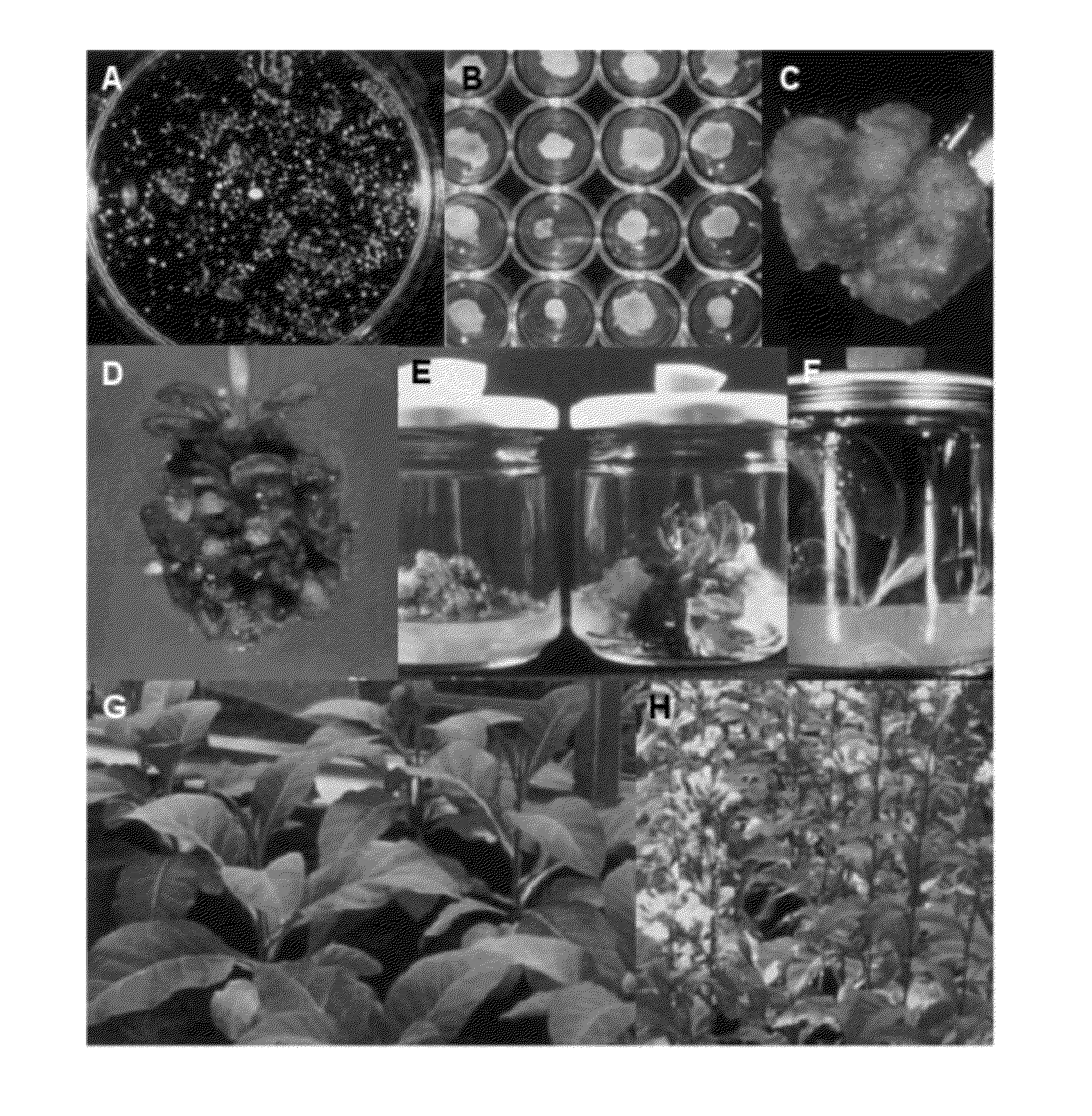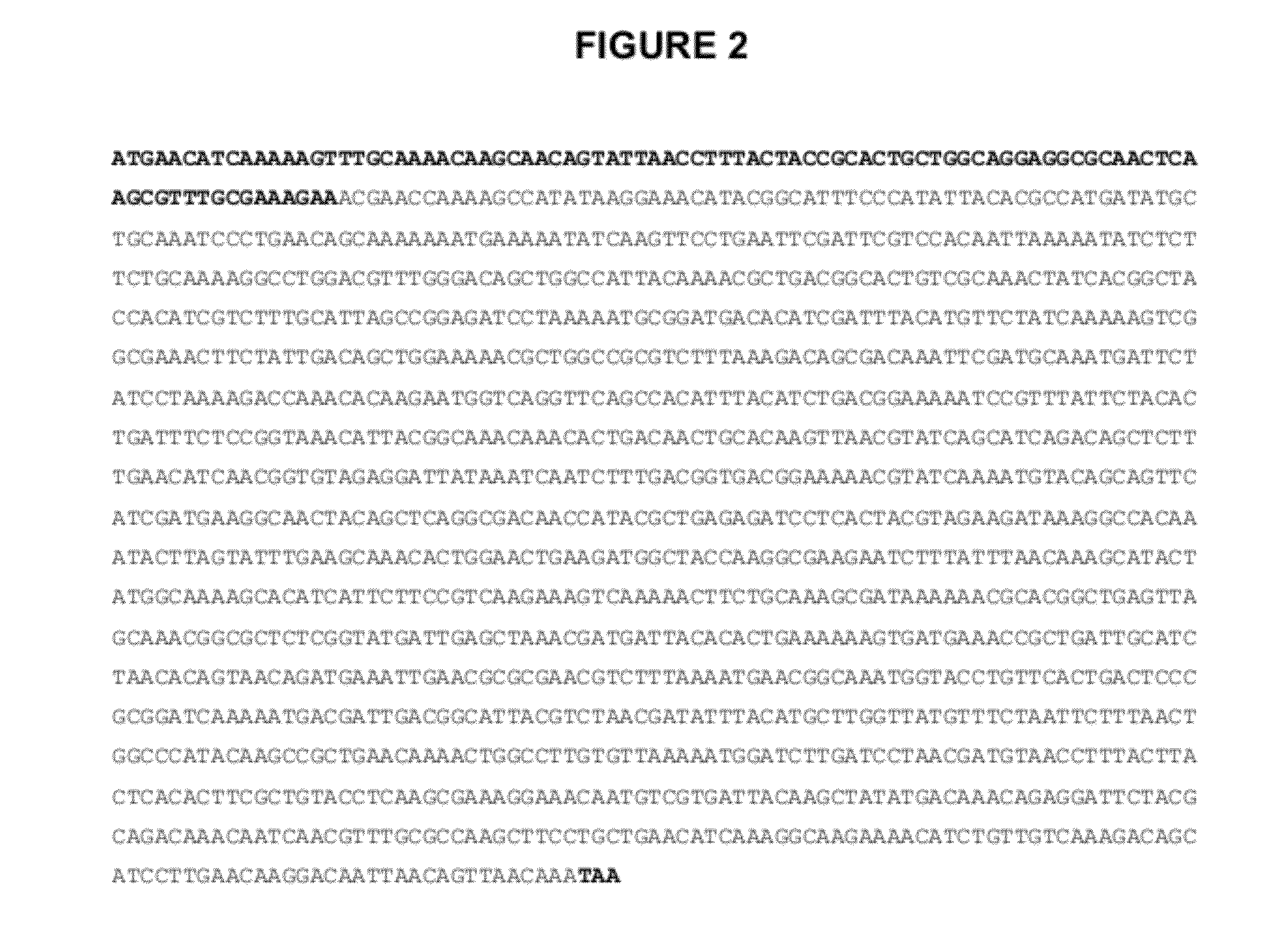Manipulating fructan biosynthesis and enhancing plant biomass
a technology of fructan and manipulating cells, applied in biochemistry apparatus and processes, enzymology, transferases, etc., can solve the problems of consuming a large amount of readily available energy in the fermentation process of rumen, and achieve the effects of increasing plant biomass, nutritional enhancement, and more accessible nutrition
- Summary
- Abstract
- Description
- Claims
- Application Information
AI Technical Summary
Benefits of technology
Problems solved by technology
Method used
Image
Examples
example 1
Isolation of Bacterial Fructan Biosynthesis Genes
[0209]FIG. 1 presents a schematic representation of SacB protein from Bacillus subtilis. The four different regions shown are: N-terminal signal sequence; N-terminal variable region; catalytic core; and C-terminal variable region. Structurally, most of the bacterial inulosucrases and levansucrases share the N-terminal signal peptide, a catalytic triad. This sequence is removed during the sequence modification. The residues involved in sucrose binding are located inside the catalytic core sequences and remain untouched during the modification.
[0210]The bacterial levansucrase (SacB) and inulosucrase (Lsc) nucleotide and protein sequences are provided in FIGS. 2-5, respectively. However, for transformation into plants the bacterial levansucrase and inulosucrase sequences are also modified in the following manner:[0211]Removal of the bacterial N-signal peptide;[0212]Adaptation of codon usage, including the start of translation for monocot...
example 2
Modification of Bacterial Fructan Biosynthesis Genes
Targeting of Bacterial FT Genes to Specific Cellular Compartments
[0216]To direct the bacterial FT genes away from the cytosol and to compartment where both sucrose and fructan accumulate the coding sequences of SacB and Lsc are modified with a putative vacuolar targeting sequence from the preprosporamin protein (SPOR531) of sweet potato (Ipomoea batatas). The propeptide of a precursor to sporamin is required for targeting of sporamin to the vacuole (Hattori et al., 1985). The vacuolar targeting information of sporamin is encoded in an amino-terminal propeptide and is indicated in FIGS. 5 and 6.
[0217]Sequence modification involves the removal of the N-signal peptide from both the SacB and Lsc bacterial fuctan biosynthesis genes and the addition of SPOR531 vacuolar targeting signal (FIGS. 7-8 and 10-11, respectively).
[0218]Prediction of subcellular localisation and topology of the modified proteins using the Secondary Structure Predi...
example 3
Generating Vectors for Stable Transformation in Dicots
Synthesis of Expression Constructs
[0221]Expression constructs utlising photosyntheic promoters, the modified bacterial fructan biosynthesis genes indicated in Example 2 and the NOS terminator sequence for transformation into dicot plants is artificially synthesised.
[0222]The use of a photosynthetic promoter expresses the genes in tissues that accumulate fructans, while the modified sequences target the protein to specific plant cell compartments.
[0223]The Ribulose-1,5-bisphosphate carboxylase / oxygenase Small subunit (RbcS) is a well-characterised light-regulated gene in higher plants. A 1700 bp fragment of the Arabidopsis thaliana Ribulose-1,5-bisphosphate carboxylase / oxygenase Small subunit (AtRbcS) promoter sequence has previously been cloned. Primers are designed to amplify a smaller fragment containing the TATA signal from the AtRbcS promoter for use in expression vectors.
[0224]The newly predicted sequences for the modified b...
PUM
| Property | Measurement | Unit |
|---|---|---|
| pore size | aaaaa | aaaaa |
| pH | aaaaa | aaaaa |
| volumes | aaaaa | aaaaa |
Abstract
Description
Claims
Application Information
 Login to View More
Login to View More - R&D
- Intellectual Property
- Life Sciences
- Materials
- Tech Scout
- Unparalleled Data Quality
- Higher Quality Content
- 60% Fewer Hallucinations
Browse by: Latest US Patents, China's latest patents, Technical Efficacy Thesaurus, Application Domain, Technology Topic, Popular Technical Reports.
© 2025 PatSnap. All rights reserved.Legal|Privacy policy|Modern Slavery Act Transparency Statement|Sitemap|About US| Contact US: help@patsnap.com



